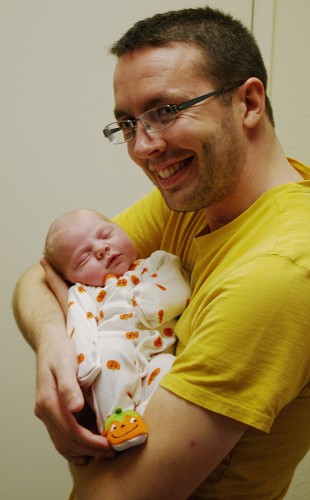I was going to include this in my post earlier, but it wouldn’t work. I don’t have any new pics of Heather, but Kyle took this video of her this afternoon. It’s nothing too exciting—just Heather being Heather.
November 28, 2011 7:54 pm
One Month of Heather
2:26 pm
Heather is one month old today. We “celebrated” by reading to her for the first time—Sometimes It’s Turkey, Sometimes It’s Feathers; Babes of the Wild; and Stanley & Rhoda. She actually did seem to enjoy it; at least, she sat quietly on my lap while I read to her.
Heather is doing well. I feel like things are starting to settle down a bit; we don’t have anything like a reliable routine or schedule yet, but things are gradually becoming more predictable. Like, if she’s awake, she’s going to want to eat every 2 hours. And at night, she’ll usually go down for a long stretch (4-6 hours) between 6 and 8pm, then sleep in 2- to 3-hour increments until morning. Her feedings are going much more smoothly these days (day and night), and she’s getting easier, overall, to get back down at night. She still doesn’t love sleeping during the day, but she’ll at least sleep for short naps (30 minutes to an hour) a couple times a day (only in her bouncer, or the car, or on a walk or something, though; she hates her crib during the day).
She really isn’t too fussy overall. She is impatient, though—most of her actual screaming is done between the time she wakes up and the time I actually start feeding her. (Less when her dad gets her up; she likes him better than me.) Other than that, she fusses when she’s gassy (which happens frequently, unfortunately, but I think it’s improving). We’re accumulating a small list of things that work (most of the time) to calm her down. In no particular order:
- Vigorous bouncing (the easiest way to do this is to sit on the exercise ball and bounce as hard as you can). If her arms aren’t flapping in the air, you’re not doing it hard enough.
- Singing (the current favorites are “Angel Lullaby,” “I Am a Child of God,” “Families Can Be Together Forever,” “I Love to See the Temple,” and whatever Kyle makes up; I particularly like his adaptation of “Little Bunny Foo Foo”).
- The sound of the hair dryer (Kyle actually recorded this and burned it to a CD so we can play it and adjust the volume easily). Sometimes this works like a magic switch—she can go from fussing to sleep in less than a minute.
- Stepping outside the front door (the current theory is that the cold air just snaps her out of her fussing cycle; alternatively, she could just be really sensitive to overheating).
- Pushing her legs up to her stomach (not so much bicycling them, but pressing them both up at the same time for a few seconds at a time).
- Putting her down (sometimes, apparently, she just wants to be left alone). We stumbled upon this one because she loves lying on her changing table. I think it’s her favorite place.
- Sucking on her pacifier. We went through 3 different kinds to find one she would like, but the winner is the Nuk. Even that one she won’t take all the time, but when she wants to suck, it’s a gem. I was going to wait several weeks to give her a binky, but when Mom came out, she told me there was no way Heather really wanted to eat every ten minutes, for 2 minutes, for hours at a time—she just wanted to suck on something. So we started trying when she was a little over a week old, and finding one she liked totally saved me.
- Sitting in her bouncy seat with the vibration on. This is actually where she is napping right now.
I keep meaning to try a bath, but I’m scared because she did scream through that once (it was time to eat, and like I said, she can be impatient). She really enjoys her baths in general, though, so I’ll have to give it a whirl sometime.
Kyle is back at work now (he started back last week, but only Monday and Tuesday, and he spent the afternoons working from home). It’s been a pretty smooth day, though. When she wakes up, I’m going to feed her and then go for a walk that may take me by Dairy Queen to celebrate a successful first day alone with the drgn. Who knows.
Too much to drink
November 25, 2011 5:50 pm
Heather At Home
November 1, 2011 9:26 pm
We left the hospital late Monday evening and got home around 11:45. We put Heather in the Halloween sleeper we bought her for the ride home. So she still got to wear it on Halloween. We didn’t get any pictures then due to being exhausted, but we managed to get a lot of sleep last night (Jess got over 3 hours!).
We’ve been using the sleeper again today so we did get some pictures:
And, no, I haven’t shaved since Friday or Saturday.
Heather Elizabeth Dickerson
October 28, 2011 8:07 pm





